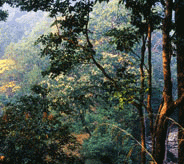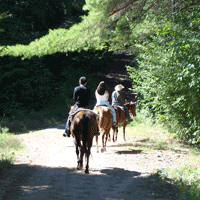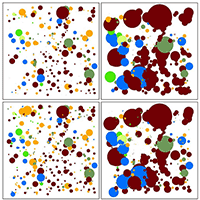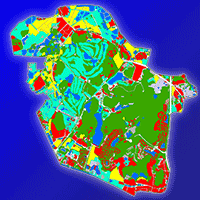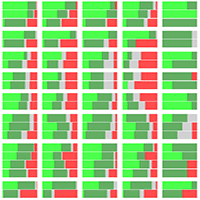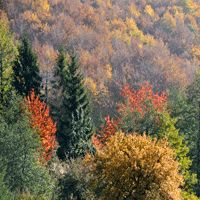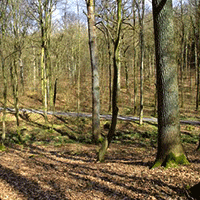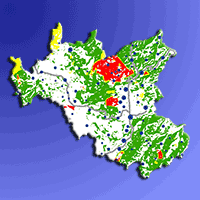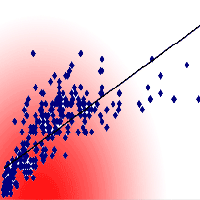
Community based forest management and its impact on vegetation: a case study
P Kumar (1) , S Hate (2), A Chaturvedi (2)
iForest - Biogeosciences and Forestry, Volume 2, Issue 3, Pages 93-98 (2009)
doi: https://doi.org/10.3832/ifor0490-002
Published: Jun 10, 2009 - Copyright © 2009 SISEF
Research Articles
Abstract
The main focus of this case study was to reveal richness, uniqueness and economic importance of the minor forest producing species (MFPs). International Forest Resources and Institutions (IFRI) techniques were used to collect biophysical information pertaining to forest, vegetation and socio economy of dwellers. Ninety plots were demarcated to represent all types of vegetation and linked to social and institutional parameters. The regeneration status of the plant species was correlated to different resource utilization management practices, which includes harvesting practices as well as associated anthropogenic disturbances. The present paper tries to relate the usage of minor forest produces and its reflection on richness and diversity of the ecosystem. With above objects in mind, this paper brings out the role of community forest management and its impact on vegetation and sustainable development of aboriginals based on successive field work from three villages, Markegaon, Devulgaon and Ranvahi of Gadchiroli district of Maharashtra, India. An attempt has been made to develop a model for sustainable development and management of minor forest producing species.
Keywords
Sustainable development, Minor forest produces, Conservation of biodiversity, Community forestry, Forest analysis
Authors’ Info
Authors’ address
Defence Institute of High Altitude Research, Defence R&D Organisation, Govt. of India, Leh - Ladakh, c/o 56 APO, 194101 (India)
Corresponding author
Paper Info
Citation
Kumar P, Hate S, Chaturvedi A (2009). Community based forest management and its impact on vegetation: a case study. iForest 2: 93-98. - doi: 10.3832/ifor0490-002
Academic Editor
Marco Borghetti
Paper history
Received: Oct 16, 2008
Accepted: Jan 09, 2009
First online: Jun 10, 2009
Publication Date: Jun 10, 2009
Publication Time: 5.07 months
Copyright Information
© SISEF - The Italian Society of Silviculture and Forest Ecology 2009
Open Access
This article is distributed under the terms of the Creative Commons Attribution-Non Commercial 4.0 International (https://creativecommons.org/licenses/by-nc/4.0/), which permits unrestricted use, distribution, and reproduction in any medium, provided you give appropriate credit to the original author(s) and the source, provide a link to the Creative Commons license, and indicate if changes were made.
Web Metrics
Breakdown by View Type
Article Usage
Total Article Views: 56015
(from publication date up to now)
Breakdown by View Type
HTML Page Views: 46790
Abstract Page Views: 3456
PDF Downloads: 4641
Citation/Reference Downloads: 57
XML Downloads: 1071
Web Metrics
Days since publication: 6038
Overall contacts: 56015
Avg. contacts per week: 64.94
Citation Metrics
Article Citations
Article citations are based on data periodically collected from the Clarivate Web of Science web site
(last update: Mar 2025)
Total number of cites (since 2009): 2
Average cites per year: 0.12
Publication Metrics
by Dimensions ©
Articles citing this article
List of the papers citing this article based on CrossRef Cited-by.
References
Land use decisions by locals affecting spatial biodiversity. In: “Advancing Frontiers of Ecological Researches in India” (Kandya AK, Asha G eds), pp. 143-160.
Gscholar
Ethno-botanical observations in Pench National Park, Maharashtra, India. In: “Advances in Ethnobotany” (Das AP ed). Bisensingh Mahendrapal Singh Publisher, Dehradun, India, pp. 119-206.
Gscholar
The Flora of the presidency of Bombay. Botanical Survey of India press, Culcutta, India, vol. I & II.
Gscholar
The vegetation of Wisconsin. An ordination of plant communities. Madison, Wisconsin Press, USA.
Gscholar
Community-based forest management and land-use planning: a case study from Maharashtra. Van Vigyan 41 (1-4): 115-130.
Gscholar
Studies on the organization of animal communities. Journal of Ecology 52: 527-539.
Gscholar
International Forest Resources and Institutions (IFRI) Field Manual (version 10.5). Workshop in political theory and policy analysis. Indiana University, Bloomington, Indiana, USA.
Gscholar
Forestry and economic development. Indian Journal of Agricultural Economics 43: 237.
Gscholar
The link between local participation and improved conservation: a review of issues and experiences. In: “Natural connections: perspectives in community-based conservation” (Western D and Wright M eds). Island Press, Washington, DC, pp. 347-372.
Gscholar
Tenurial rights and community-based conservation. In: “Natural connections: perspectives in community-based conservation” (Western D and Wright M eds). Island Press, Washington, DC, pp. 347-372.
Gscholar
Common property: what is it good for, and what makes it work? In: “People and forests - communities, institutions and governance” (Gibson, McKean and Ostrom eds), pp. 27-56
Gscholar
Conserving the world’s biological diversity. Global Biodiversity Assessment, UNEP, CUP, UK.
Gscholar
Carbon sequestration strategy of Nubra Valley with special reference to agro-forestry. DRDO Technology Spectrum, pp. 187-192.
Gscholar
Carbon pool of orchards in siachen sector: socio-economic carbon sequestration. In: “Advances in agriculture environment and health” (Singh SB, Charassia OP, Yadav S eds), pp. 225-233.
Gscholar
Methods of vegetation study. Holt-dryden Books, Henry Holt and Co. Inc., New York, NY, USA.
Gscholar
The mathematical theory of communication. Univ. Illinois Press, Urbana, IL, USA.
Gscholar
Management of minor forest produce for sustainability. New Delhi, Oxford.
Gscholar


